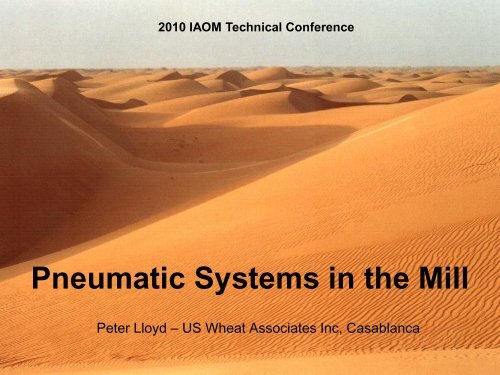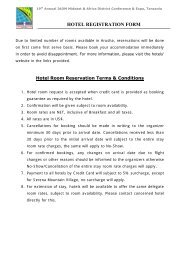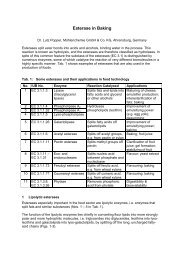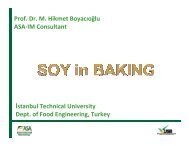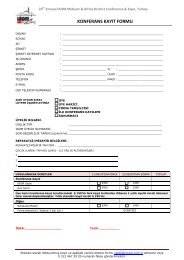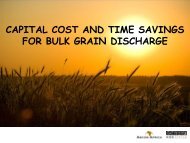Technical Session - Tech#-05 - US Wheat Associates
Technical Session - Tech#-05 - US Wheat Associates
Technical Session - Tech#-05 - US Wheat Associates
Create successful ePaper yourself
Turn your PDF publications into a flip-book with our unique Google optimized e-Paper software.
2010 IAOM <strong>Technical</strong> Conference<br />
Pneumatic Systems in the Mill<br />
Peter Lloyd – <strong>US</strong> <strong>Wheat</strong> <strong>Associates</strong> Inc, Casablanca<br />
1
A pastime nobody enjoys!<br />
2
In summary<br />
• Pneumatic conveying is quite simple –<br />
pneumatic systems are NOT.<br />
• This presentation is not designed to teach you<br />
how to design a system, but to understand how<br />
one works.<br />
• PLEASE REFER TO YOUR EQUIPMENT<br />
SUPPLIERS FOR GUIDANCE!! – they are the<br />
only ones who know everything about how<br />
YOUR system was designed.<br />
3
Bernoulli’s Law<br />
P1<br />
Pressure<br />
P2<br />
No<br />
Vacuum<br />
D1<br />
D2<br />
D1/d2=p1/p2=v2/v1<br />
v1<br />
Velocity<br />
v<br />
2<br />
Diameter is<br />
directly<br />
proportional to<br />
velocity, but<br />
inversely<br />
proportional to<br />
pressure<br />
4
Pneumatic Conveying phases;<br />
Dense phase, solid plugs<br />
Unused in milling today<br />
>200m. 10+ bar pressure<br />
Both at less than Vterm for wheat<br />
Medium phase, pulsing<br />
Blowlines<br />
Mixing Rates: the ability of air to carry products.<br />
2.5-3kg of<br />
product<br />
Most people can<br />
easily carry 25kg.<br />
1kg of Air<br />
It is all about the WEIGHT<br />
of air and the weight of<br />
products.<br />
6
Come and see us in Morocco<br />
7
Understanding the basics.<br />
• Terminal Velocity<br />
• Volume and density.<br />
• Resistance and pressure.<br />
8
Terminal Velocity – Wikipedia ®<br />
An object is moving at its terminal velocity if its speed is<br />
constant due to the restraining force exerted by the air<br />
A free-falling object achieves its terminal velocity when the<br />
downward force of gravity (F g ) equals the upward force of<br />
drag (F d ). This causes the net force on the object to be<br />
zero, resulting in an acceleration of zero.<br />
As the object accelerates (usually downwards due to<br />
gravity), the drag force acting on the object increases,<br />
causing the acceleration to decrease. At a particular speed,<br />
the drag force produced will equal the object's weight (mg).<br />
At this point the object ceases to accelerate altogether and<br />
continues falling at a constant speed called terminal<br />
velocity (also called settling velocity). Terminal velocity<br />
varies directly with the ratio of weight to drag. More drag<br />
means a lower terminal velocity, while increased weight<br />
means a higher terminal velocity.
Determining VTERM<br />
At equilibrium, the net force is zero (F =<br />
0);<br />
Solving for v yields<br />
At equilibrium, the net<br />
force is zero (F = 0);<br />
V t = terminal velocity,<br />
m = mass of the falling object,<br />
g = acceleration due to<br />
gravity,<br />
C d = drag coefficient,<br />
ρ = density of the fluid through<br />
which the object is falling, and<br />
A = projected area of the<br />
object.<br />
Solving for v yields
Grain dust 0.97 190 3.17<br />
Terminal Velocity – imperial and metric units<br />
m/sec ft/min ft/sec<br />
Corn 9.19 1810 30.17<br />
Soybeans 8.13 1600 26.67<br />
Sorghum 8.18 1610 26.83<br />
<strong>Wheat</strong> grains 7.77 1530 25.50<br />
Oats 6.20 1220 20.33
Effect of temperature<br />
Temperature<br />
in °C<br />
Density of air<br />
ρ in kg·m −3<br />
0 1.292<br />
+5 1.269<br />
+10 1.247<br />
+15 1.225<br />
+20 1.204<br />
+25 1.184<br />
+30 1.164<br />
+35 1.146<br />
• Air density is 1.2kg/M3<br />
at 16⁰ C at sea level.<br />
• Density reduces with<br />
temperature and altitude.<br />
• In most parts of North<br />
Africa, in summer, the air<br />
density can be considered<br />
as approximately 1.1<br />
kg/M3<br />
Air Density<br />
Effect of altitude
Psychrometric Charts – nothing to do with IQ!!<br />
13
Cyclone<br />
Cyclone<br />
Low pressure<br />
pneumatic system of<br />
1960's<br />
Very efficient use of power<br />
Large diameters, low velocity, low pressure<br />
and low Kw/ton<br />
High pressure<br />
pneumatic system of<br />
today<br />
Small diameters, high velocity, high<br />
pressure<br />
Accellerator<br />
Mechanical accelerator<br />
14
d<br />
r<br />
h<br />
<br />
Volume . r<br />
2 . h<br />
15
d<br />
r<br />
volume<br />
<br />
r<br />
2<br />
h<br />
<br />
*<br />
h<br />
16
d<br />
r<br />
h<br />
2 volume <br />
x diameter (<br />
<br />
. h<br />
<br />
d<br />
)<br />
17
In 1 Second:<br />
H = (velocity of air * 1000) in mm/sec<br />
Volume = (M 3 /minute) * (1000^2 /60) in mm 3 /sec<br />
2 volume <br />
x diameter ( )<br />
<br />
. h<br />
<br />
d<br />
18
Tabarka, Tunisia<br />
19
For example;<br />
• Feedrate = 1.0kg/sec (3,600kg/hr)<br />
• Mixing rate = 2.5kg/kg of air<br />
• Air Velocity = 22m/sec<br />
• Air Density = 1.2kg/m 3<br />
Feedrate <br />
ConveyingV olume /<br />
Mixingrate <br />
Density<br />
Conveying Volume<br />
<br />
<br />
<br />
<br />
1kgof<br />
product<br />
2.5kg/<br />
kgof air<br />
<br />
<br />
<br />
/1.2<br />
= 0.3334 M 3 /sec or<br />
333,333,333.33mm 3 /sec<br />
20
2 volume <br />
x diameter ( )<br />
<br />
. h<br />
<br />
d<br />
Working in millimeters, we now find that:<br />
333333333 .33 <br />
2x<br />
<br />
<br />
<br />
.20000 <br />
140.553mm<br />
Diameter of the pipe for this load = 140.553mm<br />
But – nobody makes 140.553 mm ID pipes = we would use a 140mm i/d<br />
pipe (and adjust the mixing rate accordingly).<br />
21
<strong>US</strong>E A SPREADSHEET!<br />
Feedrate 1 kg/sec 3,600 kg/hr<br />
mixing rate 2.5 kg/kg air<br />
Velocity 22 m/sec<br />
Density 1.2 kg/m3<br />
Volume 0.3333333 m3/sec<br />
Volume in mm3 333333333 mm3/sec<br />
=SQRT((B8/(PI()*(B5*10000))))<br />
Given:<br />
Feedrate, velocity and air<br />
density – you can easily<br />
work out the pipe diameter.<br />
Call the airport if you need<br />
to know the air density on<br />
any particular day.<br />
The density of air under<br />
standard conditions is<br />
1.239 kg per cubic meter<br />
under standard conditions.<br />
(16 deg C at sea level)<br />
Radius 70.2765 mm<br />
Diameter 140.553 mm<br />
22
Part 2 - pressure<br />
• Think of a truck delivering flour to a<br />
customer.<br />
23
The energy budget:<br />
Calculating the amount of fuel used by the<br />
truck is a function of;<br />
• Size of truck to carry the load<br />
• Distance traveled<br />
• Type of road<br />
• Fuel consumption (hills, corners etc.)<br />
• Part of the fuel is to move the truck, and<br />
part for the load.<br />
24
YIELD<br />
Customer<br />
Steep hill<br />
Km total = 10<br />
Stops = 2<br />
Corners = 2<br />
Roundabouts = 1<br />
Hill = 1<br />
City<br />
25<br />
Factory
1l<br />
2l<br />
1l<br />
1l<br />
YIELD<br />
1l<br />
Customer<br />
10l<br />
Steep hill<br />
Calculation of the fuel used for<br />
each part of the journey.<br />
Total<br />
Consumption:<br />
23 litres of<br />
diesel<br />
4l<br />
1l<br />
1l<br />
City<br />
1l<br />
Factory<br />
26
i<br />
h<br />
g<br />
f<br />
e<br />
d<br />
c<br />
It’s the same for pneumatics!<br />
a<br />
b<br />
27
Elements of resistance<br />
d<br />
r<br />
g<br />
v<br />
28
Energy to move the truck<br />
Plant:<br />
Land:<br />
Plant Capacity:<br />
Grain:<br />
Blunder Milling<br />
Dakar, Sénégal<br />
250.00 Tonnes per 24 hours<br />
Soft <strong>Wheat</strong><br />
Altitude: 12 Metres A.M.S.L<br />
Max ambient temperature: 28 Degrees C<br />
Initial Mixing Rate : 2.5 Kg stock/Kg air<br />
System Velocity : 22.0 Metres / Second<br />
Conveying Density 1.171 Kg/M2 Calculated<br />
Resistance Column 3 CALC Calculated<br />
29
Resistance mm SWG/M<br />
Pneumatic Piping<br />
30.0<br />
25.0<br />
20.0<br />
15.0<br />
10.0<br />
5.0<br />
0.0<br />
0 50 100 150 200 250<br />
Pipe Diameter mm<br />
22m/sec 24m/sec 26m/sec<br />
30
Line Number Line 1<br />
From Purpose From From Purpose<br />
To Purpose To To Purpose<br />
Stock Qty. in kg/h Stock Qty. 3,600<br />
Selected mixing rate stck:air mixing rate 2.50<br />
Vertical Conveying Metres Vertical 25.0<br />
Horizontal Conveying Metres Horizontal 12.0<br />
No.of Bends V/Horiz V/Horiz 1<br />
No.of Bends H/Vert H/Vert 1<br />
No.of Bends H/H H/H 1<br />
Calculated Air volume cbm/h Air volume 1,229<br />
Calculated Pipe Diameter Pipe diam 140.5533<br />
Resistance column 3<br />
Resistance mm/m ResistanceM 4.2 mm/m<br />
Metres ConveyingM 42 m<br />
31
Resist Mix Rate 2.5 himixrate 0.96<br />
Basic Air Pressure mm W.G. Pbasic 320<br />
Accleration Resistance mm W.G Paccel 71<br />
Horizontal Pipe resist mm W.G Phoriz 48<br />
Vertical Pipe resist mm W.G Pvert 246<br />
Bends (all) Pipe resist mm W.G Pbends 101<br />
Conveying Pressure mm W.G. Pconv 465<br />
Total Line Pressure mm W.G. Ptot 785<br />
Manifold Loss mm W.G. Pmanif 12.5<br />
Total Pressure mm W.G. Ptot 797<br />
=<br />
+<br />
Seal Leakage cbm/hr Vseal 123<br />
Total Volume cbm/hr Vtot 1352<br />
Total Volume cbm/min 22.530<br />
Total Volume cbm/sec 0.375<br />
32
Line Number 2<br />
From<br />
B1a<br />
To<br />
B1 Sift<br />
% of B1 Stock 25.0%<br />
Stock Qty. in kg/h 2,604.17<br />
Air volumecbm/h<br />
749.89 Calc<br />
CalculatedPipeDiameter<br />
110.00 Calc<br />
Selected mixing rate 2.96<br />
Vertical Conveying Metres 25.00<br />
Horizontal Conveying Metres 12.00<br />
No.ofBends V/Horiz 1.00<br />
No.ofBends H/Vert 1.00<br />
No.ofBends H/H<br />
Basic Air Pressure mm W.G.<br />
393.20 Calc<br />
Accleration Resistance mm W.G<br />
83.96 Calc<br />
HorizontalPipe resistmm W.G<br />
46.81 Calc<br />
Vertical Pipe resist mm W.G<br />
291.28 Calc<br />
Bends (all)Pipe resistmm W.G<br />
71.75 Calc<br />
Conveying Pressuremm W.G.<br />
493.80 Calc<br />
Total Line Pressuremm W.G.<br />
887.00 Calc<br />
Seal Leakage cbm/hr<br />
74.99 Calc<br />
Manifold Loss mm W.G.<br />
13.00 Calc<br />
TotalPressure mm W.G.<br />
900.00 Calc<br />
Total Volume cbm/hr<br />
824.88 Calc<br />
Energy budget<br />
for a single<br />
conveying line.<br />
33
So you want the formulae?<br />
• Basic Pressure: =(ResistanceM*ConveyingM)+(120*(VELOCITY/20)^2)<br />
• Acceleration:=sel_mixing_rate*(9.83*(24-VELOCITY)*(22-VELOCITY)-<br />
17.33*(26-VELOCITY)*(22-VELOCITY)+3.54*(26-VELOCITY)*(24-<br />
VELOCITY))<br />
• Horizontal Conveying:<br />
=Horizontal*sel_mixing_rate*IF(sel_mixing_rate
For this ONE conveying line:<br />
• Total volume:<br />
• Total pressure:<br />
• Capacity:<br />
• Lift Diameter:<br />
• Cyclone Size:<br />
825 M 3 /hr<br />
900 mm swg<br />
2,600 kg/hr<br />
110 mm Ø<br />
360 mm Ø<br />
NOW it gets a little tougher:<br />
35
Now, to a conveying SYSTEM<br />
Corniche Kabiyle, Jijel, Algeria<br />
36
Fan Selection Data ;<br />
Blunder Milling<br />
Item Pressure Volume<br />
Conveying System 925 mm WG 24,004 cbm/hr<br />
Manifold to Filter 36 mm WG -<br />
Filter Resistance 60 mm WG -<br />
Manifold to Fan 35 mm WG -<br />
Manifold from Fan 35 mm WG -<br />
Jet Cap resistance 25 mm WG -<br />
Totals 1,117 mm WG 24,004 cbm/hr<br />
Mixing and Imbalance % 15 %<br />
Fan Design values 1,284 mm WG 27,6<strong>05</strong> cbm/hr<br />
OK<br />
460.076 cbm/min<br />
7.668 cbm/sec<br />
Temperature<br />
Altitude<br />
Fan Inlet Pressure & Volume Density<br />
Estimated Power consumption :-<br />
28 Degrees<br />
12 mamsl<br />
1.171 Kg/CbM<br />
164.09 Kw<br />
37
31,746 m 3 /hr<br />
WHY?<br />
27,6<strong>05</strong> m 3 /hr<br />
LP<br />
Fan<br />
HP<br />
Fan<br />
Filter Design values:<br />
LP Fan Design values:<br />
38
Filter Design values: 1,284 mm WG 27,6<strong>05</strong> m 3 /hr<br />
39
mm W.G. Ptot<br />
mm W.G. Ptot<br />
1400<br />
1200<br />
1000<br />
800<br />
600<br />
400<br />
200<br />
1. Highest pressure must not be B1!!<br />
2. Lowest pressure should not be less than 70%<br />
of highest (Stability rate).<br />
0<br />
1 2 3 4 5 6 7 8 9 10 11 12 13 14 15 16 17 18 19 20 21 22 23 24 25 26 27 28 29 30 31 32 33 34 35 36 37 38 39 40 41 42 43<br />
40
Cubic Metres / hr<br />
10<br />
11<br />
12<br />
13<br />
14<br />
15<br />
16<br />
17<br />
18<br />
19<br />
20<br />
21<br />
22<br />
23<br />
24<br />
25<br />
26<br />
27<br />
28<br />
29<br />
30<br />
31<br />
32<br />
33<br />
34<br />
35<br />
36<br />
37<br />
38<br />
39<br />
40<br />
41<br />
42<br />
43<br />
mm SWG<br />
STABILITY<br />
Stability = pMin/pMax<br />
Systems should be >= 80%<br />
1200<br />
1100<br />
1000<br />
900<br />
Pressure & Volume<br />
Total Volume<br />
Total Pressure<br />
1200<br />
1100<br />
1000<br />
B1 M<strong>US</strong>T NOT BE<br />
pMax.<br />
800<br />
700<br />
600<br />
500<br />
900<br />
800<br />
700<br />
400<br />
300<br />
600<br />
200<br />
1<br />
2<br />
3<br />
4<br />
5<br />
6<br />
789<br />
500<br />
PMin in system 786 mm swg<br />
PMax in system 925 mm swg<br />
Stability 85% percent<br />
Lifts 43 count<br />
Stable System<br />
Lift #<br />
41
Pressure<br />
Kw<br />
Understanding a fan curve.<br />
surge<br />
PMax<br />
P Op.<br />
Pressure/volume<br />
power<br />
Volume<br />
More air = more power<br />
& less pressure.
Pressure<br />
Kilowatts<br />
Fan Curve<br />
1600<br />
400<br />
design point (peak pressure point +5%)<br />
1400<br />
350<br />
1200<br />
300<br />
1000<br />
air only<br />
250<br />
800<br />
Power consumed<br />
200<br />
600<br />
150<br />
400<br />
Pressure/Volume<br />
100<br />
200<br />
50<br />
0<br />
0 200 400 600 800 1000 1200<br />
0<br />
Q: What happens when you close<br />
the main air valve?<br />
Volume<br />
43
Fan Laws<br />
1. Volume varies as RPM.<br />
2. Static Pressure varies as square of RPM.<br />
3. Power varies as cube of RPM<br />
Double the rpm = square the pressure = cube the power.
What does this mean?<br />
Item Original Revised<br />
Speed 2,500 2,900 RPM<br />
Volume 23,000 26,880 Cu M / Hr<br />
Pressure 1,200 1,614 mm swg<br />
Power 212 330 Kw<br />
Be very careful playing with the speed of your fan!
In summary<br />
• Pneumatic conveying is quite simple –<br />
pneumatic systems are NOT.<br />
• This presentation is not designed to teach you<br />
how to design a system, but to understand how<br />
one works.<br />
• PLEASE REFER TO YOUR EQUIPMENT<br />
SUPPLIERS FOR GUIDANCE!! – they are the<br />
only ones who know everything about how<br />
YOUR system was designed.<br />
46
• From all of us at <strong>US</strong> <strong>Wheat</strong>, THANKS<br />
FOR YOUR ATTENTION – this is not an<br />
easy subject to transmit in 20 minutes.<br />
• Ngiyabonga, Enkosi and Thank You!<br />
47


